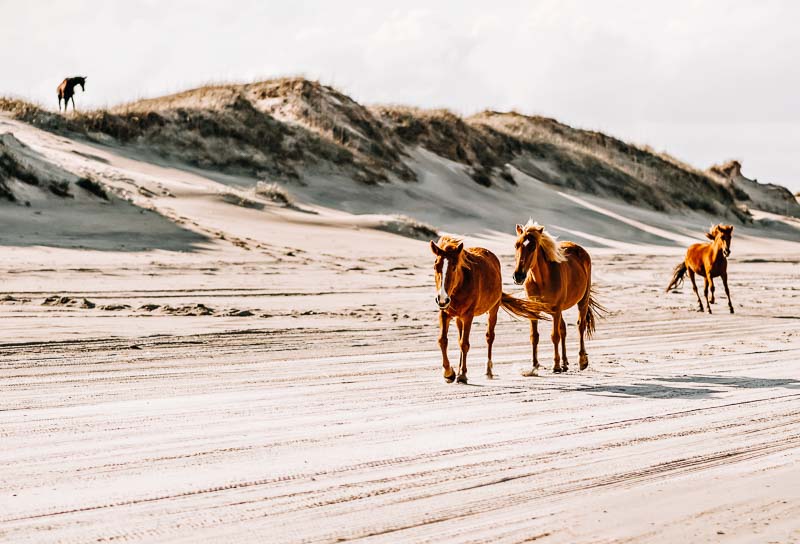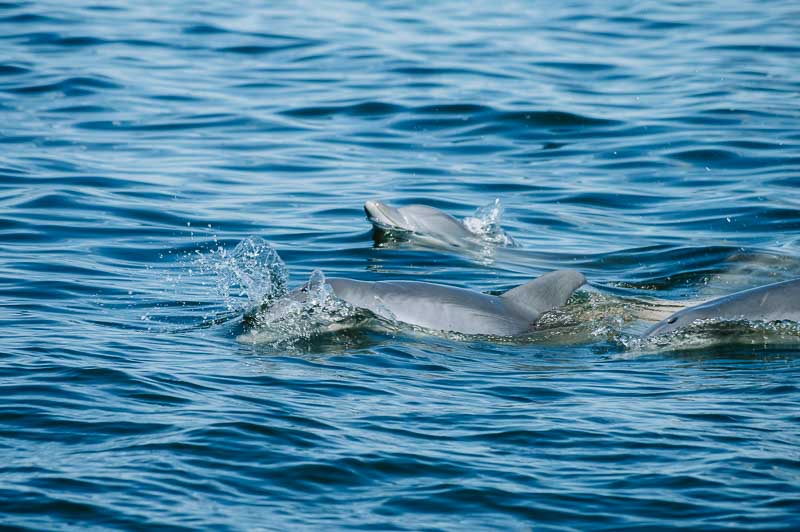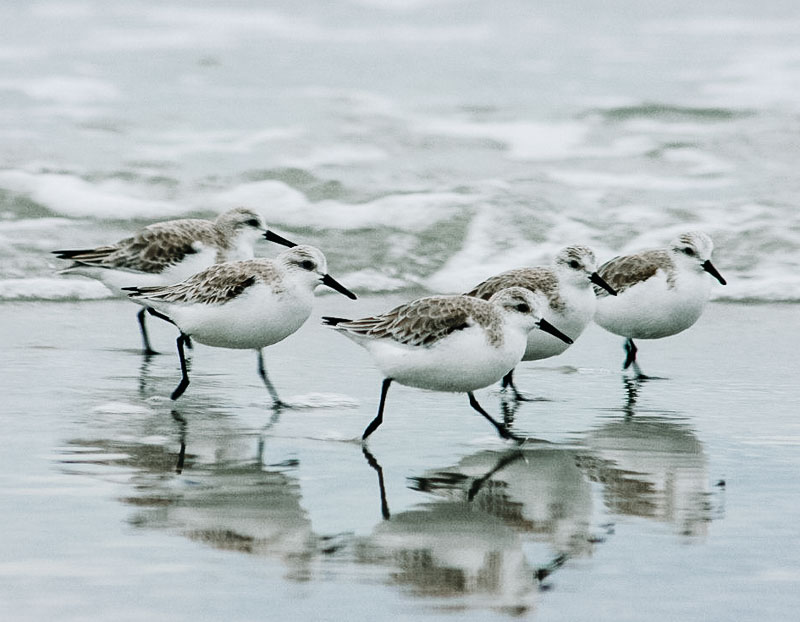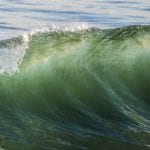The Outer Banks isn’t just home to some of the most beautiful beaches in the country, it’s also home to some of the most diverse and important wildlife; and we’re not just talking about seagulls. Depending on the season, you can see some of the coolest animals that call the OBX home. Some that might even surprise you! The animals listed can be seen year round but the most common sightings happen during the seasons listed below. See which animals call the Outer Banks home and how to find them right now!
Spring Outer Banks Animals
Wild Horses

Wild Horses have been Outer Banks natives since the 16th century; dating back to the expeditions of Sir Richard Grenville. The horses call Corolla home and hang out in small herds together. The wild horses can be seen just about anywhere around the 4 wheel drive areas of Corolla. The Corolla Wild Horse Fund helps manage herds and keep the wild horses of Corolla safe.
You can see the wild horses of Corolla just about any time of year, but the best time is the spring, from mid April to the end of May. The beaches are less crowded and it’s also mating season for the horses. As you seek them out, keep in mind that you have to stay 50 feet away from them at all times. This includes petting and leaving behind food for the horses to eat. There is a county ordinance that makes it illegal for people to come within 50 feet of the horses. Violation of this ordinance can result in a fine up to $500 for each infraction. You can get more information on the Corolla wild horses and the Corolla Wild Horse Fund here.
Black Bears

The Outer Banks is made up of more than just beaches. We have a vast landscape of marsh and woodland. The Alligator River National Wildlife Refuge spans over 152,000 acres and is made up of marsh and wooded wetlands. The refuge is home to what is believed to be the largest population of black bears in the southeastern United States. Black bears will sometimes swim across the sound and make their way over to Nags Head, like they did during the summer of 2020. Black bears hibernate during the late fall and winter months, but then emerge from their dens in March or early April with their cubs on the hunt for food.
Summer Outer Banks Animals
Sea Turtles

The Outer Banks is a visiting place for 5 different species of sea turtles; Loggerhead, Green, Kemp’s Ridley, Hawksbill, and Leatherback though a Hawksbill or Leatherback sea turtle sighting is rare. These sea turtles make the Outer Banks home from early to mid-summer to lay their eggs. While female sea turtles come ashore to lay their eggs, healthy sea turtles never come to shore. During the spring months on the Outer Banks you may come across sea turtle nests on the beach. You might even catch a mama turtle laying eggs. If you see a sea turtle nest or a sea turtle on the beach, leave them alone. N.E.S.T has a full list of tips on how to help sea turtles on the Outer Banks.
Dolphins

According to the Outer Banks Center for Dolphin Research, there have been more than 800 dolphins in the Roanoke Sound since 2008. The mid-atlantic bottlenose dolphins are frequently seen in Beaufort, NC during the winter months. Then, when it warms up, they like to come visit the Outer Banks sounds from May to October! There are also some locals that live in the sounds of the Outer Banks, the OBCDR has named a few! You can also take part in a dolphin tour where you can learn more about the dolphins that call the OBX home!
Alligator

People may think the Alligator River is named for its inhabitants, but it’s actually named for its shape! However, the Outer Banks is still home to the American Alligator. Alligators inhabit areas north of the refuge and in some of our waterways. You can see alligators in the Alligator River, Milltail Creek, Sawyer Lake, and in the border canals that line Highway 64/264 in Manns Harbor and Stumpy Point! Alligator sightings on the Outer Banks are rare, but they’re not impossible. Alligators are shy Outer Banks animals that like to spend their time in the water. Sometimes, you can even catch them sunbathing on a log in the summer!
Fox

The summer months for foxes means kit-rearing season! Kits or pups are young foxes and during the summertime, young foxes and their parents are out and about exploring their environment. North Carolina is home to gray and red foxes, so you may spot both roaming around the woods or even in your neighborhood. The gray fox is native to North Carolina. Red foxes were brought here from Europe by hunters in the early 1700s. Both species only stand about 12-16 inches tall at the shoulder and weigh between 7-15 pounds.
Fall Outer Banks Animals
Canada Goose

The Canada Goose can stand anywhere between 25 and 43 inches tall. They’re mostly gray with a black head and neck. Over the years, the Canada goose has become more adapted to the Outer Banks climate and is mostly a year round inhabitant, but more frequently seen in the Fall and Winter months on the Outer Banks.
Sandpipers

The little teeny birds you see scurrying away from the shorebreak are sandpipers! While you may see them year round, they are more frequently seen in the fall months.
Great Blue Heron

This Outer Banks animal is the most commonly seen heron. The Great Blue Heron is between 42 and 52 inches tall and lives in treetops over the water. They can live in groups as large as 100 other herons! They eat small fish, frogs, insects, and snakes. The Great Blue Heron can be seen during the months of January through March and July through December.
Winter Outer Banks Animals
Seals

Seals like harp and harbor seals make the Outer Banks their home in the winter. They love cold to cool inshore waters and like to hangout near rocks but it isn’t unusual to see one on sandbars and areas of sand soaking up the sun. You can sometimes see seals on the beaches of the Outer Banks from Corolla all the way down to Oregon Inlet.
Year Round Outer Banks Animals
Rabbits

Marsh rabbits and eastern cottontails are the common species of rabbit that are found in grassy areas around Roanoke Island, Bodie Island, Hatteras Island, and around the Wright Brothers Memorial!
Deer

White-tailed deer are common sight on the Outer Banks! You can normally spot them in more wooded areas like Nags Head Woods but you can also see them along the grassy areas of Highway 12. Deer are nocturnal animals that come out at night. However, it’s not uncommon to see them during the day.
Red Wolves

Red wolves call the Outer Banks home. About 40 red wolves roam the Alligator River National Wildlife Refuge. Red wolves are still an endangered animal and it’s not common to see them in residential areas. You can go on a Red Wolf Howling Safari to see them up close and personal.
Nutria

While you may think this little guy is a beaver or otter, it’s not! A nutria is actually a large, semi-aquatic rodent that’s originally native to South America. It’s larger than a muskrat but smaller than a beaver. In the early 1940s, Nutria were introduced to Hatteras Island and then spread into the Currituck Sound. You can see nutria along the banks of marshes, swamps, and canals year round.












